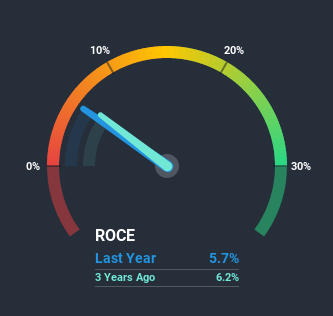Returns On Capital At Severn Trent (LON:SVT) Paint An Interesting Picture

If you're looking for a multi-bagger, there's a few things to keep an eye out for. Ideally, a business will show two trends; firstly a growing return on capital employed (ROCE) and secondly, an increasing amount of capital employed. Ultimately, this demonstrates that it's a business that is reinvesting profits at increasing rates of return. Although, when we looked at Severn Trent (LON:SVT), it didn't seem to tick all of these boxes.
What is Return On Capital Employed (ROCE)?
For those who don't know, ROCE is a measure of a company's yearly pre-tax profit (its return), relative to the capital employed in the business. To calculate this metric for Severn Trent, this is the formula:
Return on Capital Employed = Earnings Before Interest and Tax (EBIT) ÷ (Total Assets - Current Liabilities)
0.057 = UK£557m ÷ (UK£11b - UK£1.1b) (Based on the trailing twelve months to March 2020).
Thus, Severn Trent has an ROCE of 5.7%. In absolute terms, that's a low return but it's around the Water Utilities industry average of 5.3%.
View our latest analysis for Severn Trent
Above you can see how the current ROCE for Severn Trent compares to its prior returns on capital, but there's only so much you can tell from the past. If you're interested, you can view the analysts predictions in our free report on analyst forecasts for the company.
The Trend Of ROCE
The returns on capital haven't changed much for Severn Trent in recent years. Over the past five years, ROCE has remained relatively flat at around 5.7% and the business has deployed 31% more capital into its operations. This poor ROCE doesn't inspire confidence right now, and with the increase in capital employed, it's evident that the business isn't deploying the funds into high return investments.
In Conclusion...
In conclusion, Severn Trent has been investing more capital into the business, but returns on that capital haven't increased. And with the stock having returned a mere 40% in the last five years to shareholders, you could argue that they're aware of these lackluster trends. As a result, if you're hunting for a multi-bagger, we think you'd have more luck elsewhere.
If you'd like to know more about Severn Trent, we've spotted 3 warning signs, and 1 of them makes us a bit uncomfortable.
While Severn Trent isn't earning the highest return, check out this free list of companies that are earning high returns on equity with solid balance sheets.
This article by Simply Wall St is general in nature. It does not constitute a recommendation to buy or sell any stock, and does not take account of your objectives, or your financial situation. We aim to bring you long-term focused analysis driven by fundamental data. Note that our analysis may not factor in the latest price-sensitive company announcements or qualitative material. Simply Wall St has no position in any stocks mentioned.
Have feedback on this article? Concerned about the content? Get in touch with us directly. Alternatively, email editorial-team@simplywallst.com.

 Yahoo News
Yahoo News 

